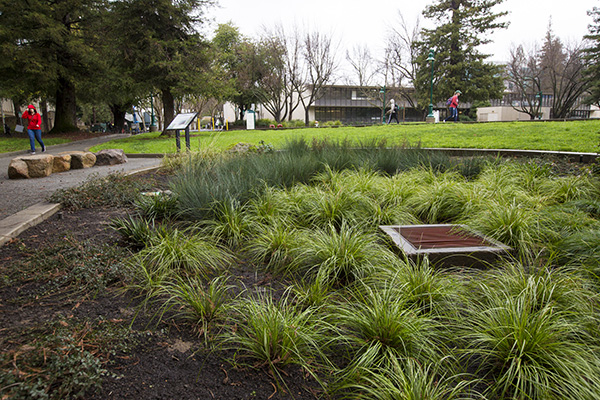 A maturing rain garden and porous pavement in the Library Green are among the many campus stormwater-management devices that ensure clean water runs into the American River. (Sacramento State/Jessica Vernone)
A maturing rain garden and porous pavement in the Library Green are among the many campus stormwater-management devices that ensure clean water runs into the American River. (Sacramento State/Jessica Vernone)PLUS: Ryan Todd builds ‘culture of sustainability’ at Sac State
Sacramento State’s award-winning stormwater-management project is cleverly disguised as tidy gardens sprouting drought-tolerant plants and porous walkways made of crunchy-looking concrete.
The 24 LID (low-impact development) devices in seven campus locations collect and filter 2.9 million gallons of rainwater each year, greatly reducing the University’s impact on the neighboring American River. Sediment and metal loads flowing into the river from those seven locations are down 60 percent to 90 percent on average.
“The whole project is about protecting the American River,” says Maureen Kerner, research engineer with Sacramento State’s Office of Water Programs (OWP). “Before this project, stormwater runoff on campus was collected and pumped over the levee directly into the river, carrying pollutants with it.”
Sac State is protecting the river’s many beneficial uses, including Sacramento’s municipal water supply, the aquatic habitat, and recreational boating, swimming, and fishing.
In 2014, the state Water Resources Control Board awarded OWP and the City of Sacramento $2.6 million in Proposition 84 clean-water funds to design, build, and monitor the LID project. Sacramento State added $500,000 in matching funds, and the City of Sacramento contributed another $112,000. Construction began in June 2015.
Today, the system of innovative LID devices – bioretention planters, a flow-through planter, rain gardens, an infiltrating bioswale, roof downspout disconnects, and porous pavement – is functioning as planned. In addition to reducing stormwater runoff into the river and preventing erosion, the devices replenish campus groundwater supplies that are used for irrigation.
“You will see many more devices pop up around campus as the University implements its Master Plan to expand green-space connectivity and better manage stormwater through more aesthetic and sustainable practices,” Kerner says.
Plans include installing stormwater planters and a dry well near Parking Structure V, which will be built on the site of the current Parking Lot 1. The dry well will include a pretreatment vault where pollutants will settle before the runoff is directed into a 20-foot subsurface well to recharge the groundwater.
“The LID project has gone a long way in promoting the use of sustainable stormwater practices locally and regionally,” Kerner says. “Several other colleges and universities are mimicking our project and installing stormwater planters and porous pavement.”
The campus LID project has won two major awards: The California Stormwater Quality Association (CASQA) last year named it the state’s outstanding stormwater best management practices implementation project. And, in 2015, the Sacramento section of the American Society of Civil Engineers recognized it as the region’s best urban development project.
The LID team has created an array of educational materials related to the project, including eye-catching signs posted at the seven locations, as well as one near the west end of the Guy West Bridge. Sacramento State computer science students helped the LID team develop a self-guided walking tour – owp.csus.edu/lid – for mobile devices as a part of their senior-design project. It has had more than 800 unique views since its launch in September 2016.
And the campus LID website (owp.csus.edu/csus-lid) is a great resource for anyone planning a similar project. It includes design plans, construction information, monitoring details, and a rundown of the drought-tolerant plants used in the project.
“The plants are an important component of LID, so we listed them all in case people visiting campus want something similar for their own property,” Kerner says.
The successful campus LID project adds to Sacramento State’s reputation as one of the world’s most sustainable campuses.
Last year, for instance, the Association for the Advancement of Sustainability in Higher Education (AASHE) – a national nonprofit that empowers higher education institutions worldwide to lead the sustainability movement – awarded Sac State a Gold rating. That put the University in elite company among the 650 colleges and universities on six continents that voluntarily report to STARS, the association’s sustainability tracking system. Sac State has the highest score in the 23-campus California State University (CSU).
AASHE also named Sac State a top performer in its 2016 Sustainable Campus Index, giving it a No. 3 overall ranking among master’s institutions (schools that award at least 50 master’s degrees and fewer than 20 doctoral degrees annually). – Dixie Reid
